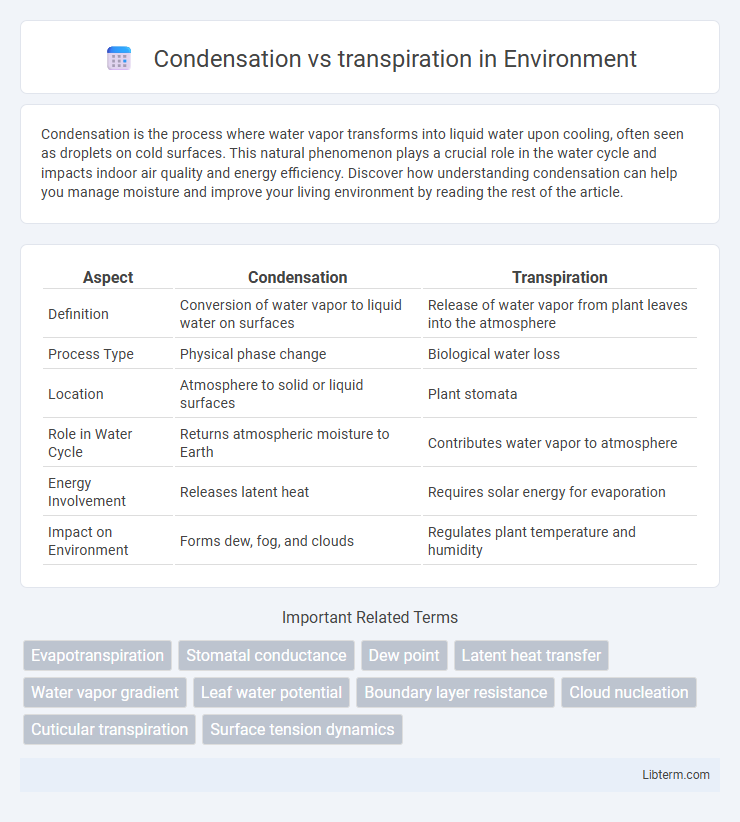Condensation is the process where water vapor transforms into liquid water upon cooling, often seen as droplets on cold surfaces. This natural phenomenon plays a crucial role in the water cycle and impacts indoor air quality and energy efficiency. Discover how understanding condensation can help you manage moisture and improve your living environment by reading the rest of the article.
Table of Comparison
| Aspect | Condensation | Transpiration |
|---|---|---|
| Definition | Conversion of water vapor to liquid water on surfaces | Release of water vapor from plant leaves into the atmosphere |
| Process Type | Physical phase change | Biological water loss |
| Location | Atmosphere to solid or liquid surfaces | Plant stomata |
| Role in Water Cycle | Returns atmospheric moisture to Earth | Contributes water vapor to atmosphere |
| Energy Involvement | Releases latent heat | Requires solar energy for evaporation |
| Impact on Environment | Forms dew, fog, and clouds | Regulates plant temperature and humidity |
Introduction to Condensation and Transpiration
Condensation is the process where water vapor in the air cools and changes into liquid droplets, playing a key role in cloud formation and the water cycle. Transpiration involves the release of water vapor from plant leaves into the atmosphere, contributing to humidity and regulating plant temperature. Both processes drive the movement of water within ecosystems but operate through different physical mechanisms--condensation through cooling of air and transpiration through biological activity in plants.
The Basics of the Water Cycle
Condensation and transpiration are essential processes within the water cycle that regulate water movement in the environment. Condensation occurs when water vapor cools and changes into liquid droplets, forming clouds, while transpiration involves the release of water vapor from plant leaves into the atmosphere. These processes contribute to atmospheric moisture and influence precipitation patterns critical for sustaining ecosystems.
What is Condensation?
Condensation is the process by which water vapor in the air cools and changes into liquid water, forming droplets on surfaces or as clouds. This phase change releases latent heat, playing a critical role in the Earth's water cycle and weather patterns. Unlike transpiration, which involves water vapor release from plants, condensation is a physical transformation primarily influenced by temperature and humidity.
What is Transpiration?
Transpiration is the process by which water vapor is released from the stomata of plants into the atmosphere, playing a critical role in the water cycle and maintaining plant hydration. It regulates temperature through evaporative cooling and facilitates nutrient uptake by creating a negative pressure that draws water from roots to leaves. Unlike condensation, which involves the cooling of water vapor into liquid droplets, transpiration is a biological mechanism essential for plant survival and ecosystem balance.
Key Differences Between Condensation and Transpiration
Condensation is the physical process where water vapor changes into liquid water droplets, primarily occurring in the atmosphere and on surfaces, while transpiration is the biological process by which plants release water vapor through stomata in their leaves. Condensation results in phenomena like dew formation and fog, directly influencing weather and climate patterns, whereas transpiration plays a critical role in the water cycle by facilitating water movement from soil to atmosphere and aiding in plant cooling and nutrient transport. The key difference lies in condensation being a phase change driven by temperature and humidity, whereas transpiration is a physiological process governed by plant biology and environmental factors.
The Role of Condensation in the Environment
Condensation plays a crucial role in the water cycle by transforming water vapor into liquid droplets, which contribute to cloud formation and precipitation essential for replenishing freshwater sources. This process regulates atmospheric moisture levels, influencing weather patterns and maintaining ecological balance in terrestrial and aquatic ecosystems. In contrast to transpiration, where plants release water vapor into the atmosphere, condensation facilitates the return of water to the Earth's surface, completing the cycle and supporting sustainability.
The Significance of Transpiration for Plants
Transpiration plays a crucial role in maintaining plant health by regulating water movement, facilitating nutrient uptake, and cooling leaves through evaporative loss. Unlike condensation, which involves water vapor turning into liquid, transpiration actively drives water transport from roots to leaves, sustaining photosynthesis and growth. This process also helps create a negative pressure that supports the ascent of sap within xylem vessels.
Factors Influencing Condensation and Transpiration
Temperature, humidity, and surface characteristics significantly influence condensation by affecting the air's saturation point and moisture accumulation on surfaces. Transpiration rates depend primarily on plant species, stomatal conductance, ambient temperature, humidity, and soil moisture availability. Wind speed and solar radiation also impact both processes by altering evaporation rates and moisture exchange dynamics with the environment.
Condensation vs Transpiration: Real-World Examples
Condensation occurs when water vapor in the air cools and changes into liquid droplets, as seen in dew forming on grass or fog on windows. Transpiration is the process by which plants release water vapor through stomata, contributing to the water cycle and atmospheric humidity, commonly observed in forest ecosystems. These processes are interconnected, with transpiration supplying moisture that can condense into precipitation, influencing weather patterns and plant hydration.
Summary and Environmental Implications
Condensation involves the transformation of water vapor into liquid droplets, playing a crucial role in cloud formation and precipitation, while transpiration is the process by which plants release water vapor through stomata, contributing to atmospheric moisture. The balance between condensation and transpiration influences local and global water cycles, affecting climate regulation and ecosystem health. Disruptions in these processes due to deforestation or climate change can lead to altered rainfall patterns, soil moisture deficits, and reduced biodiversity.
Condensation Infographic

 libterm.com
libterm.com